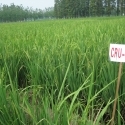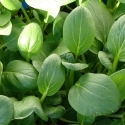08 Nov 2012
Identifying gaps in mulberry fertilization in Hubei Province
A recent survey of the province’s mulberry gardens identified a wide range of common practices that are significant barriers to sustained productivity.

Mulberry leaf production provides the sole uninterrupted source of food required by the silkworm (Bombyx mori). In turn, silk industries of the world depend on this one source. Silkworms produce valuable cocoons made of a single continuous thread of raw silk from 300 to 900 meters (m) long. An estimated 4,000 to 6,500 cocoons are required to make 1 kg of silk, and at least 30 million kg of raw silk are produced each year, requiring nearly 4.5 billion kg of mulberry leaves.
Fertilization plays a very important role for enhancing mulberry productivity and improving soil fertility. Local research suggests that proper nutrient management can increase mulberry leaf yields by 35% and can also improve leaf qualities (Tan et al., 1997; Wang et al., 2001). Hubei Province is one of the main silk production regions in China. Recent estimates of Hubei’s area planted to mulberry place it at over 23,300 ha. Although mulberry planting occurs throughout Hubei, the largest activities occur in the eastern part of the province where 70% of the total area is located. High-yielding mulberry varieties have extended throughout Hubei, and soil nutrient removal has increased accordingly along with the frequency of soil nutrient deficiencies. Research shows that balanced fertilization is a key to advancing sustainable development of mulberry production within the province (Lu et al., 2004).
Since 2002, the authors have established balanced fertilization field trials and demonstrations for mulberry throughout Hubei. This work also included a comprehensive survey of 44 mulberry gardens in six counties. The survey collected information on the range of fertilization rates, measures, fertilizer products, and common nutrient management practices. The results of the survey provide the basis for the following discussion on mulberry leaf production in Hubei and identify the present limitations resulting from the continuation of common practices.
The survey of fertilizers available for mulberry found a selection of organic manures and commercial fertilizers (Table 1). Organic manures include compost, pond mud, human excreta, pig and cattle dung, and green manures. Commercial fertilizers included urea, ammonium bicarbonate, calcium superphosphate, potassium chloride (KCl), and two common compound fertilizer formulas, 12-16-7 and 15-15-15. It was evident that more site-specific formulas are required as a limited choice of fertilizer formulas would fail to provide the balanced quantities of nutrients required by the majority of mulberry fields in the province. About 75% of mulberry fields used organic manures and 52% of these were composted materials. Of all the nitrogen (N) being applied, 74% was from commercial fertilizers. All mulberry fields used commercial N fertilizer — 89% used ammonium bicarbonate while 32% used urea.
Application of phosphorus (P) and potassium (K) fertilizers was generally inadequate across all sites surveyed. Of all the P being applied in Hubei, 70% originated from organic manures. In the more extensive production centers in the east, manures represented 92% of the total P supply. Commercial P fertilizer was utilized on 32% of mulberry fields, with 20% using calcium superphosphate and the remaining 12% relying upon compound sources. Of the five sites specifically using compound fertilizers, three belonged to a state-run silkworm breeding farm characterized as having greater awareness on science-based farming methods compared to those sites run by individual farmers. Only 18% of sites used K fertilizers with 7% specifically using KCl —the remaining 11% also relying on available compound fertilizer products. Organic manures represented 87% of the total K being applied.
Nutrient application rates for mulberry fields were regionallybased with rates being highest in the east compared to the smaller production centers in the north and southwest (Table 2). The provincial averages for N, P, and K were: 453 kg N/ha (range = 171 to 936); 114 kg P2O5/ha (range 0 to 300); 176 kg K2O/ha; (range 0 to 576). Nitrogen application was above 150 kg/ha for all fields and half were above 450 kg/ha (Table 3). Application of P and K was completely omitted from 14% and 25% of mulberry fields, respectively, and surveyors noted a great impact on mulberry leaf productivity in those cases.
For the mulberry gardens investigated, 25% used one annual nutrient application, which usually consisted of only manure applied in the winter season; 60% used two applications split between winter and summer; 10% used three splits; and only 5% use four split applications. Fertilization practices for the most advanced operations often included: 1) a basal dressing (about 10% of the total) in late February to early March prior to leaf emergence consisting of manure plus some fertilizer applied in a groove encircling the tree; 2) fertilizer (70% of the total) applied in holes located around the trees in June to early July after leaf harvesting and pruning. Some mulberry gardens will also broadcast urea and/or organic manure at this time; 3) fertilizer (about 15% of the total) applied after the summer silkworm sericulture in late August; and 4) fertilizer (about 5% of the total) applied in December after the entire year’s sericulture (silk production) is completed.
Conclusion
The survey identified some significant nutrient management issues presently limiting mulberry production in Hubei. Great differences in fertilization rates and management levels exist among regions and even among mulberry gardens in close proximity. Nitrogen fertilization for mulberry has reached a relative high level in Hubei, but P and K rates are low and unbalanced with present N fertilization rates. Fertilization rates in the eastern region are higher than other regions and there is a larger dependence on manures, especially for P and K. In the southwest, fertilization and soil fertility are especially low and increased application of both manures and commercial fertilizers is advised.
Split nutrient applications are under-utilized for mulberry and the minimum practice of three split applications is recommended in order to better match the seasonal nutrient requirements.




